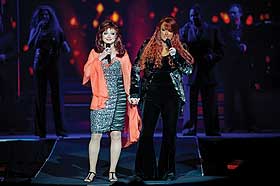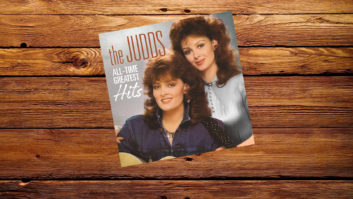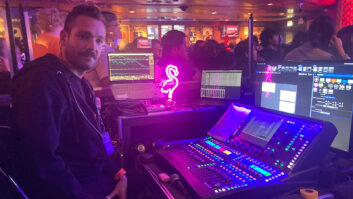
When mother/daughter team Naomi and Wynonna Judd decided to join forces onstage for their The Last Encore tour, the duo looked within their road family to bring their vocal harmonies to adoring fans. Front-of-house engineer Curtis Flatt has been mixing for Wynonna on and off since 2002, while monitor engineer Pete Parenteau has toured with her since 2005. Both have done a few Judds dates in the interim and so were able to create this tour’s sound design relatively quickly.
“We started designing the show first because it’s real different from the Wynonna show,” Flatt says. “The band’s a little bit bigger, with the Palmetto State Quartet added to it; a little bit different instrumentation. The nice part was that one of the key players in the band is the Judds’ producer, Don Potter. So during rehearsals, I recorded everything in Pro Tools and I could set up my mixes and have [Potter] come back, and we could say ‘This works,’ ‘This doesn’t work,’ ‘Can we change what they’re playing?’ ‘Can I use more EQ?’ It’s really nice to have somebody in the band who fluently speaks audio.”
Enriching the sound design was Flatt’s experience with a d&b system; he’s been with Spectrum Sound (Nashville) for the past 25 years and found that it was a no-brainer to go with the sound company’s J Series system. “I sat down with Jeremy Seawell, who is my assistant on this tour, and we talked about what we thought would be the best for coverage in the arenas so that we could get things as even and as smooth as possible,” Flatt says. “We’re both fans of the d&b J Series; it was pretty easy to lay out exactly what we wanted and tailor it around the thrust—we didn’t find out about the thrust until after we had made the design.”
The system includes 14 J8s over two J12s for the front hang. “They pull down pretty hard,” Flatt describes. “We had to take it up pretty high. Trim was 30 to 35 feet to the bottom of the P.A. every night so that the sightlines weren’t obscuring the big video wall behind it.” Side system included 14 J12s, five J-subs for side hang and a dozen B2s distributed evenly across the front of the stage to even out the ground-fill. The pockets saw Q10s, while E3s were at the edge of the thrust. Two Q-subs (one SL and one SR) helped warm up Parenteau’s ear mixes. “We had a few different settings or macros brought up so that when [The Judds] went out on the thrust, we would pull down the lower part of the P.A. a little more and bring up the thrust fills a little more so that you felt like they were right there,” Flatt says.
Performing in so many different types of arenas made it key to ensure that the engineers could create an accurate-sounding system each night,.And because there are, at any time, up to eight vocalists in front of the thrust of the P.A., the system must be perfectly tuned. Flatt uses a combination of his ears and Smaart, the latter for time-alignment issues and to “look and see if there was anything strange. I’d also use a couple of tracks that were shown to me by d&b—the ones they used when they were designing the boxes—that really fill out well. The only difference [in the system hang] was the angles depending on the room. Outside of that, the coverage was fine every night and we just tried to keep it off the walls.
“We’re trying to keep as much energy in the show as we can, but, literally, they pulled somebody out of the audience last night who was four, [and] we know there was a man in the audience celebrating his 92nd birthday—so it’s a pretty broad age range. We find a nice, comfortable level that still has the energy in it; it’s very dynamic. The parts of the show that are quiet, they’re really quiet. The songs that are more pop or R&B-oriented we tend to push a little bit more, but not to the point where the people who don’t want that are going to get up and leave; they’re going to enjoy it as well. We want to make sure the coverage is as even as we can get across the room. While we may have as many boxes as they have on shows that are louder than this one, we want to make sure it’s tapered and tailored to the room.”
BOARD SELECTIONS
Flatt mans an Avid Profile, which he calls his go-to desk because it’s a good-sounding board and it doesn’t take up much space (helpful for a tour that has a large lighting world). “Also, I can span my arms from one side of it to the other so it’s easy to move around. It’s very intuitive to use; I’ve been on it since it came out, so it’s very familiar to my fingers.” Flatt’s using most of the onboard stock plug-ins, including ReVibe reverb and Bomb Factory models. He’s also working with a Massey CT4 plug-in for Wynonna’s vocal (“I find it to be a really nice, fat compressor/limiter”), Serato (“Having eight vocals in front of the P.A. at once, it’s very handy”) and SPL Transient Designer. “I only keep a little bit of the impact that I want on the percussion elements, which is a pretty low level because it’s a family-oriented show.”
With the addition of Naomi Judd and the increased band, Parentau switched from a Yamaha PM5D to a Midas XL8. “In the past, my first choice would have been the PM1D: I love the control surface, workflow and stability of that system. But Spectrum Sound had just acquired an XL8 and I was happy to be the first one in the company to take it out! The pre’s sound amazing, and the band has noticed a big difference right away. They commented on the overall sonic quality and natural, open feel to all the inputs.” Parentau is using 12 internal reverbs. All background vocalists have their own discrete reverb; a hall and a plate are used on Wynonna Judd. He also employs a drum plate, a ’verb for the mandolin and two for acoustics. “I tend to mix in the box and keep things simple and the audio path as clean as possible and easy to troubleshoot,” Parentau explains. “I try not to use compression at all and let the players control their own dynamics. I have a few in place for coloration, but not for correction.”
A SHURE BET
All mics onstage are Shure models. According to Flatt, Shure has taken care of The Judds longer than he’s been with them. The Judds sing through KSM9s on UR4 wireless packages, while background vocals take KSM9s. The Quartet is on Beta 58s. “Everything else is standard,” Flatt adds. “A 57 on guitar amp, 98s on drums, KSM32s for overheads; nothing really out of the box on this one.”
When miking drum overheads, Flatt tends to put the mics almost in front of the overheads rather than over the top as there’s enough cymbal going around onstage with nine open vocal mics. “And what we’re looking for is more of the ‘swish’ rather than the crash we’re picking up, just to give it a little bit of feel,” the FOH engineer adds. “We had a block of 2-inch foam cut that went almost around the 57 on the snare top to keep the hi-hat out of it. The drummer literally plays the hi-hat right over the top of the snare. That’s where it was really good to have their producer with us, because I could ask him, ‘How do you deal with this in the studio?’ ‘Well, I kinda don’t’.” [Laughs]
Shure also provided stereo in-ears—a mix of PSM 900, PSM 700 and P6HW units. Parenteau is responsible for 15 stereo mixes, with most of the bandmembers having basic mixes with their voice or instrument on top of a full band mix. “I mix Wynonna’s off of the VCAs because the show is very dynamic and I have to make sure she can hear all of her cues, whether it be from the acoustic guitar player, piano or background vocals,” Parenteau says. “This technique carried over from her solo shows and helped make the transition to arenas more seamless.” The 12 VCAs and the POP groups on the XL8 help keep the inputs easily accessible for Parenteau. Coordinating 14 channels of ears and 12 RF mics is no easy task, but Parenteau relies on a WinRadio to scan the environment and a Wireless Workbench to check for intermods. “Overall, I only had a few tough days and it was better than I thought it would be. Once we got a routine in place, the show couldn’t have gone smoother.” Parenteau makes special mention to production manager Art Rich, stage manager Albert West, and backline techs Wade Hooker and Ed Turner, who made his job easy.
Adds Flatt: “[This tour] has one very powerful singer and one very quiet singer. The challenge was blending those two together and keeping them in front of the P.A. The best technique is talking to them, which they’re really good about. One of them understands if you’re standing too close at this moment, the other one will be in your microphone. They’re really good about hearing what you have to say and being receptive to it. They’ve sung together all of [Wynonna Judd’s] life, and they know how to blend with each other. They’re really open to knowing that the surroundings are a little bit different today and you just tell them, and that makes it really nice for me.”






